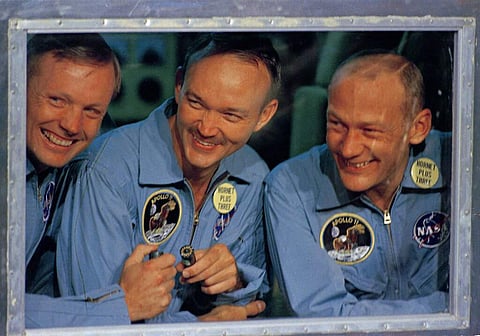
- LIFESTYLE
- FASHION
- FOOD
- ENTERTAINMENT
- EVENTS
- CULTURE
- VIDEOS
- WEB STORIES
- GALLERIES
- GADGETS
- CAR & BIKE
- SOCIETY
- TRAVEL
- NORTH EAST
- INDULGE CONNECT

HONOLULU (AP): Neil Armstrong, Edwin 'Buzz' Aldrin and Michael Collins' trip to the moon concluded with a stay in Hawaii.
This week marked the 50th anniversary of the moon landing, but after those historic first steps NASA still had to get the three astronauts safely back to Earth — and the waters off Hawaii are where the cone-shaped spacecraft splashed down.
The Honolulu Star-Advertiser reported Wednesday, the anniversary of the astronaut's return to Earth, that the crew hit the atmosphere at 25,000 mph, creating a fireball that was visible to the crew of the waiting recovery aircraft carrier USS Hornet stationed about 900 miles (1,448 km) southwest of Hawaii.
"It was like a shooting star when it came out of the sky," recalled Vance Hege, who was a 20-year-old Marine on the Hornet 13 miles from the splashdown site.
After two sonic booms, three huge parachutes slowed the descent to the Pacific Ocean.
Hege, now a 70-year-old Columbus, Indiana, resident, said the Navy "had helicopters all around" the command module after it splashed down in the Pacific.
The astronauts were scooped up and placed in quarantine, where the trio was met by President Richard Nixon and returned to Pearl Harbor.
About 25,000 people watched on July 26, 1969 as the astronauts made a 3-mile (4.8 km) trip to board their flight back to Houston.
"It looked like a Kamehameha Day parade — and that was just to see the trailer," said state Archivist Adam Jansen.
The astronauts were only able to look out a closed window on the sealed camper as cheering and flag-waving spectators lined the route.
"Just to see the trailer that the astronauts were in — it was just that monumental of an occasion," Jansen said.
12-year-old boy ran all 3 miles alongside the quarantine unit, which was on a flatbed truck, "so he could keep his eye on his heroes," the Sunday Honolulu Star-Bulletin and Advertiser reported at the time.
Then-Gov. John A. Burns told the astronauts through a microphone system that Hawaii was "immensely proud" to be the first state to welcome the trio back from the moon.
"We would just like to thank you for being here," Armstrong said from inside the unit. "This is perhaps the warmest welcome that any man or group of men have ever witnessed."
"It was all of you — all of mankind had a role in what we were able to accomplish," Collins said. "We have seen some amazing sights, but I've not seen anything half as beautiful as the island of Oahu this morning."
Puma’s Space Explorer Pack is an ode to the 50th anniversary of the moon landing
Rare Nike 'Moon Shoe' breaks record, sells for $437,500 at Sotheby's online auction
Celebrate the 50th anniversary of the moon landing with these moon-themed accessories and outfits
#Apollo50: Why has the human race remained in love with the moon?
Veena player Rajhesh Vaidhya is set to perform at The Moonshine Project, Hyderabad